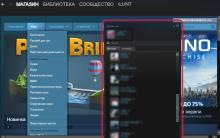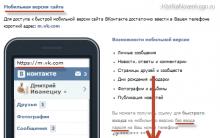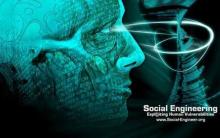Most often, we remember about BIOS (Basic Input / Output System) only when we need to reinstall the operating system and need to somehow set it to boot from a disk or flash drive. I often wrote about this in articles like:, and others. Now I want to put together and refer only to this article when necessary. This article will be useful for all versions of BIOS and for different companies. A kind of unified directory
The first thing you need to know is that BIOS is divided by manufacturer and version.
To change boot method in BIOS- you must first enter it.
You can, of course, find out what version and manufacturer of your BIOS, from the manual that comes with the computer.
You can also find out by looking at the line at the top on the black screen during boot (the manufacturer will be indicated there).
Well, then enter the BIOS, knowing what kind of BIOS you have.
In some versions of the BIOS there is no such screen with displaying lines. There is simply a logo and at the bottom it says something like "Press F2 to enter SETUP" and then press F2. If there is just a logo and there are no inscriptions - press ESC, and then del or f2
Here is a small list of manufacturers and keyboard shortcuts for entering BIOS:
Also, at the bottom of the black screen, keys are written to enter the BIOS and to display a list that contains the available devices for loading and so that you can boot from it. But about him at the end of the article.

As you can see - most often you need to press a key F2 or Del.
Now you need to put a USB flash drive or disk in the boot.
Let's look at a few examples that differ from the BIOS manufacturer.
Setting up Award Bios for booting from a USB flash drive or disk:
The main window looks like this, in which we need the second item:

Further depends on the firmware version. In one case, you will need to go to an item similar to "Boot Seq & Floppy Setup"

otherwise, you don't need to go anywhere - everything will be right before your eyes

Click on First Boot Device(First boot device), click Enter and such a window will appear

in which you need to select the disk or flash drive that will be launched first. You can specify the Second boot device, for example, but usually the BIOS fills in this data itself.
On a note:
If you choose a flash drive, then, among other things, you also need to go to the "Hard Disk Boot Priority" item and move our flash drive to the very top using the "+" and "-" or "PageUp" and "PageDown" buttons:

It is also worth remembering that in order for the BIOS to see the USB flash drive, it must be connected before turning on or before rebooting
Then we press "F10" (for the exact key, see the prompt at the bottom of the screen with the name "Save", "Exit") or go to the main BIOS menu and select the item "Save and Exit Setup". In the red window, select "Yes" with the "Y" button on the keyboard and press "Enter"

The computer will reboot and when booting from the Windows installation disc you may be prompted for a few seconds "Press any key to boot from CD or DVD ..."

Which translates as "Press any button to boot from CD or DVD".
This means that if at this moment you do not press any button on the keyboard, the computer will continue to boot from the next device in the list.
Another kind of this BIOS:
I met this only on old computers ten years ago until 2003. The main menu looks like this:

To customize the boot order, you need to go to the menu BIOS FEATURES SETUP:

At this point, we just select with the PageUp and PageDown buttons (or Enter and arrows) what to put first - CDROM or USB flash drive. Don't forget the second and third device
And further:



How to choose where to boot from in AMI BIOS
If, after entering BIOS, you see such a screen, then you have AMI BIOS:

Use the "right arrow" button on the keyboard to move to the Boot tab:

Go to "Hard Disk Drives" and in the line "1st Drive" (may be called "First Drive") select a disk or flash drive:

Next, go to "Boot Device Priority", go to "1st Boot Device" and select from the list what you have selected in the previous tab (ie if you have selected a USB flash drive in Hard Disk Drives, then you need to specify it here too. This is important! )

To boot from a CD / DVD disk, you need to select "ATAPI CD-ROM" (or simply "CDROM") in this menu, and there is no need to go to the previous menu "Hard Disk Drives".
Now we save the results by pressing "F10" or go to the BIOS section "Exit" and select "Exit Saving Changes".
Another AMI BIOS, but everything is clear here:

Configuring Phoenix-Award Bios to Boot from a USB Flash Drive
If, after entering BIOS, you see such a screen, then you have a Phoenix-Award BIOS:

We go to the “Advanced” tab and opposite the “First Boot Device” set what you need (a USB flash drive or disk):

Save with the F10 key

Configuring EFI (UEFI) Bios with a GUI to boot from a USB flash drive
Now you will not surprise anyone with this. Almost all new computers come with this kind of shell. You can read more about it in the article.
When loading, at the bottom of the screen there is a section "Boot Priority", where you can use the mouse (drag and drop) pictures to set the desired boot order.
You can also click the "Exit / Advanced mode" button in the upper right corner and select Advanced mode in the window that appears.

Next, go to the "Boot" tab and in the section Boot Option Priorities in the "Boot Option # 1" field, set the default boot device to a USB flash drive, DVD-ROM, hard disk or other available device.

How to boot from a USB flash drive or disk without entering BIOS
This is what I wrote about almost at the very beginning of the article.
This is when you need to press a key once and a window with a choice of loading will appear. This method does not change the BIOS settings.
Usually Award BIOS offers to press "F9" to call the boot menu, and AMI asks to press "F8". On notebooks, this may be the "F12" key.
In general - look at the bottom line and look for items like "Press F8 for BBS POPUP" or "Press F9 to Select Booting Device after POST".

Why can't I boot from a USB flash drive in BIOS?
Possible reasons: 
On ancient computers, there is no way to boot from USB sticks at all. If there is no newer BIOS, then the project can help.
1) Download the latest version of "Plop Boot Manager" from the link above and unpack it.
2) The archive contains files: plpbt.img - an image for a floppy disk, and plpbt.iso - an image for a CD-ROM.
3) We write the image to disk and boot from it (or from a floppy disk).
4) A menu will appear in which we select our USB flash drive and boot from it already.
Small decoding of drive designations when choosing:
Do not forget after you have done what you wanted (namely, why did you change the boot in the BIOS) - return the boot settings back so that the computer boots from the hard drive.
If this error is displayed on the monitor screen when you turn on the computer, then do not panic. There are several possible reasons why it might appear. Accordingly, there are several options for eliminating it.
What does this error mean?
First, let's figure out what the reboot and select proper boot device and press a key error means. Everything is simple here. Your computer or laptop. Simply put, he does not know where to load the operating system from. The most common boot device is the hard drive. A little further we will figure out why the PC can stop seeing the boot device and what are the options for solving this problem.
Reasons for the appearance and solution:
- Banal non-contact of cables on the hard drive.
This situation can occur because one of the two cables to the hard drive is disconnected or damaged. You should open the cover of the computer case and visually inspect the condition of these cables. It is advisable to disconnect and reconnect them, and do this both from the side of the hard drive and from the side of the motherboard. If you notice that the cables are damaged or broken in some place, they need to be replaced.
Solving the problem with the error reboot and select proper boot device and press a key
In a laptop, this situation is impossible, since there are no cables. The laptop connector is located directly on the motherboard.
- The BIOS has lost the boot priority setting.
Another fairly common reason for the error is the situation when the boot priority sequence gets lost in the BIOS settings. Or the priority of hard drives when there are several of them installed in the computer.
In this case, you need to check this setting.
To do this, go into BIOS by pressing F2, Delete, F10 or F12 and install your hard disk drive (HDD) in the first place.
This is how it looks on the AMI:

This is for the BIOS Award:

And this is for modern motherboards with UEFI BIOS:

- If you have multiple hard drives installed and one of them has an operating system. then make sure that the system drive is the first in the priorities of hard drives.


- If, after all the steps taken, the name of the hard disk in the BIOS is displayed (something similar to the previous photo), then something happened to one or more files responsible for loading the operating system.
And you have to either restore it or reinstall it. I also recommend checking your hard drive for bad sectors.
- In the worst case, when the hard drive is not displayed in the BIOS, the latter is most likely out of order and needs to be replaced.
In this article, the most common situations in which an error may appear were sounded. reboot and select proper boot device and press a key when the computer boots, as well as all sorts of options for its solution.
If nothing helped you, please unsubscribe in the comments. In the shortest possible time, we will try to answer you.
Hello! Today I rested all day, Sunday same. But in the late afternoon I thought that I needed something useful to write to my blog. I began to think what I hadn’t written yet, and what could be useful to you in the process of solving various computer breakdowns, and then the thought came that I had already written about that, and how I also wrote in it, but there is also a way by which, when turned on computer can select device to download without having to enter BIOS. I will write about this, I am sure that this advice will be useful to many.
You often have to choose from which device you need to start the computer. For example, you want, or just boot your computer from the boot disk to scan your computer for viruses. And to do this, you have to go into the BIOS, look for where this item is located in which the boot order is set, and on different computers, this is all done in different ways, and many at this stage abandon the idea of repairing the computer on their own.
If, for example, you need to boot from a CD / DVD disc or a flash drive once, then you can do without changing the settings in the BIOS. And now I will tell you how to do it.Selecting the boot device when turning on the computer
We insert the disc into the drive, or connect the USB flash drive. We restart the computer and as soon as it starts to boot, press the key F11.

A window will appear "Please select boot device:", in which using the up and down arrows we select the device we need from which we want to boot, and confirm our choice by pressing "Enter". As you can see, I have the ability to boot from a drive, a flash drive and of course a hard drive.

Which device you choose, from this one the download will go. As you can see, everything is much easier than digging into the BIOS settings. If nothing happens when you press F11, then there are at least two options:
- You have a USB keyboard, and the BIOS settings have disabled support for such keyboards when the computer starts up. You need to connect a regular keyboard, and already with its help go to BIOS and in the Integrated Peripherals item, find USB Keybord support and set the Enable value. After that, your USB keyboard should work.
- And the second case, it's just that you have a different key installed to call up the boot device selection menu when you turn on the computer, or simply this function is disabled in the same BIOS. For example, in Acer laptops in the BIOS there is an item “F12 select boot device” (or something like that), which must be enabled by setting Enable. After that, the menu will be called by pressing the F12 key.
It seems that he wrote everything, there will be questions, ask. Good luck!
Very often, users are faced with an error such as "Reboot and select proper boot device or insert boot media". This error appears immediately after turning on the computer and does not allow loading the operating system.
Fortunately, this error is not too serious and in most cases it can be eliminated without the help of a specialist and without additional material costs. Now we will look at some of the most common causes of this error and tell you what you can do.
Reason # 1. The computer is trying to boot from an external drive.
If you get the error message "Reboot and select proper boot device" when you try to turn on the computer, then the first thing to do is to disconnect all external drives (such as memory cards, external hard drives and CDs) and restart the computer. It is possible that after that the computer will start to boot normally.
Reason # 2. The computer is trying to boot from another hard drive.
Very often, the reason for the error "Reboot and select proper boot device or insert boot media" or is that the BIOS is set to incorrect settings and because of this the computer boots from another hard disk. In order to fix this problem, find the boot settings there and select the disk on which the operating system is installed.
All BIOSes are very different from each other. Therefore, it will not be possible to describe the setup process for all possible options. As an example, we will show how this is done if you have an AMI BIOS.
So, in the AMI BIOS you need to go to the "BOOT" section and open the "Hard Disk Drive BBS Priorities" menu item.
After that, you need to configure the priority of the drives at boot. To do this, simply select the first disk, the disk on which the operating system is installed. Then press the ESC key to return to the previous BIOS screen.

After that, you need to pay attention to the general list of devices used to boot the operating system. This list must also include a hard drive with an operating system.

If the hard disk you need is not in this list, then open one of the items and select the hard disk.

After making all the changes, do not forget to save them. This can be done simply by pressing the F10 key.
Reason # 3. Problems with connecting the hard drive.
If you tried to change the boot order (as described above), but did not find the drive you need in the list of disks, then most likely you have some kind of problem with. In this case, you need to check the connection of the SATA cables to the hard drive and the motherboard. These cables are not securely attached, and sometimes the contact at the connection point may be poor. Because of what the hard drive can be disconnected and then connected for no apparent reason.
Reason # 4. The hard disk is defective.
The reason is rather unlikely, but quite possible. If your hard drive is completely out of order. Then it will not be detected by the system, and you will receive the error "Reboot and select proper boot device".
Reason number 5. Dead battery on the motherboard.
Another possible cause is a dead battery on the motherboard. It is very easy to check and exclude this option. Turn off your computer and unplug it from the power supply for a few minutes. After that go to BIOS and check the time and date. If the time and date are out of order, then you need to.
Reason # 6. Damaged bootloader.
Damage to the bootloader can also result in the "Reboot and select proper boot device" error. If you have ruled out all other options, then you can try to repair the bootloader.
Restoring the bootloader on different versions of Windows is a topic for a separate article. Here we will simply demonstrate how this is done using the example of Windows 7.
Boot from the Windows 7 disk, and when a window appears prompting you to install Windows, select the "System Restore" option.


After that select "Command Prompt"

Then enter the commands "bootrec / fixmbr" and "bootrec / fixboot"

After entering these commands, close the command line and restart your computer. If the problem was in the bootloader, then the error "Reboot and select proper boot device or insert boot media" should no longer appear.
Sometimes, when trying to turn on the computer, the following text appears: Reboot and select proper boot device or Insert boot media in selected boot device and press a key. Nothing happens and the operating system is not loaded.
Now we will tell you what to do in such a situation.
1. Remove all removable media
In many cases, an impossibly simple method helps. Turn off your computer (regardless of whether it is a laptop or a PC, hold down the power button) and remove all flash drives, external hard drives from it, if there is something in the drive, remove that too.
Then turn on your device again. Everything should work, and if not, let's move on.
By the way, if this method really worked, look for the problem in your removable media. Try putting it on a different computer and see if it causes the same problems. If it does, it is better to simply format it - so you at least try to bring the drive back to life.
Then put the bootable media first in the queue. This is done in BIOS (we talked about this above).
After downloading, a list of available tools will open. Among them is the familiar to many utility Dr.Web CureIt, which perfectly copes with the search and treatment of any virus threats without installation.

Rice. # 2. Dr.Web CureIt on LiveUSB
4. If all else fails
So the problem is in the hardware. It may lie in the failure of the BIOS power supply battery, power supply malfunction and a number of other reasons.
Your best bet is to take your laptop or PC for repair, where a professional can handle it. It will be especially good if the guarantee is still valid.











Prolongation of registration of participants in the "Living Classics" competition!
Who deleted me from friends on VKontakte All friends disappeared from the contact
Which operator was the best in Russia
Double cassette tape recorder
"VK" can be closed for a long time